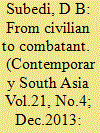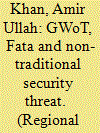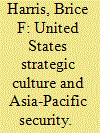| Srl | Item |
| 1 |
ID:
127081


|
|
|
|
|
| Publication |
2013.
|
| Summary/Abstract |
Although combatants played a vital role in the People's War (PW) waged by the Maoists in Nepal, there is a dearth of knowledge about what motivated or compelled people to join the war, as well as what made the Maoists so successful in recruiting and mobilising committed insurgents. Engaging with these questions, this paper aims to understand the causes and drivers of combatant recruitment in the PW. The existing literature demonstrates that armed recruitment and participation in conflict is a phenomenon driven by structural and environmental factors in addition to other conditions, including class-based oppression as well as caste and ethnic grievances. This study, however, contends that in the Nepalese context, while such structural inequalities and disparities created favourable conditions for the PW to escalate, these factors alone cannot sufficiently explain: (a) how and in what ways the Maoists radicalised people or coerced them into becoming combatants and (b) what role the insurgent organisation and the state played in the recruitment dynamics. It argues that an understanding of armed recruitment and participation in the PW should also take into account certain mobilising factors, such as the Maoists' ideology and radicalisation campaigns. Furthermore, it situates the recruitment of combatants within the security paradigm and establishes that the insecurity and violence, caused by both the insurgent organisation and the state, explain voluntary as well as involuntary modes of armed recruitment in the PW.
|
|
|
|
|
|
|
|
|
|
|
|
|
|
|
|
| 2 |
ID:
135570


|
|
|
|
|
| Summary/Abstract |
The theoretical framework exploring security changed following the end of the cold war. In the post-cold war era, strategic thinkers and policy makers developed a new discourse that took into account non-military security issue like lack of healthcare, poverty, illiteracy, unemployment, poor food, poor sanitation system, poor governance and environmental issues as non-traditional security issue. This innovative paradigm shift has helped expand the horizon of security studies. The contribution of Copenhagen school is noteworthy in this connection.
|
|
|
|
|
|
|
|
|
|
|
|
|
|
|
|
| 3 |
ID:
132874


|
|
|
|
|
| Publication |
2014.
|
| Summary/Abstract |
This article adopts an historical socio-cultural lens to analyse the United States' strategic cultural tendencies. It traces the roots of the mutually constitutive relationship between technology and political structures in the United States to explain the dominant tendency of the United States to substitute technology for strategy in war as a predisposition of national strategic culture. This predisposition was seen particularly in network-centric warfare and effects-based operations. I conclude that the United States risks strategic failure due to the limitations of its ethnocentric security paradigm. Over-reliance on technology obscures strategic understanding of the people and cultures of the world, including those of the Asia-Pacific region. The development of the AirSea Battle is a case in point, a direct application of technology to strategic concerns in the Asia-Pacific region. The strategic pivot towards the Asia-Pacific may be characterized as reflecting more historical continuity than change in America's strategic calculus. The emerging Asia-Pacific security dynamic is no different a challenge for American policy-makers in that regard than challenges presented elsewhere in the world. Perhaps the biggest challenge for American leaders is to overcome institutional intransigence or the lure of ideological conformity when addressing military requirements and budgetary commitments.
|
|
|
|
|
|
|
|
|
|
|
|
|
|
|
|